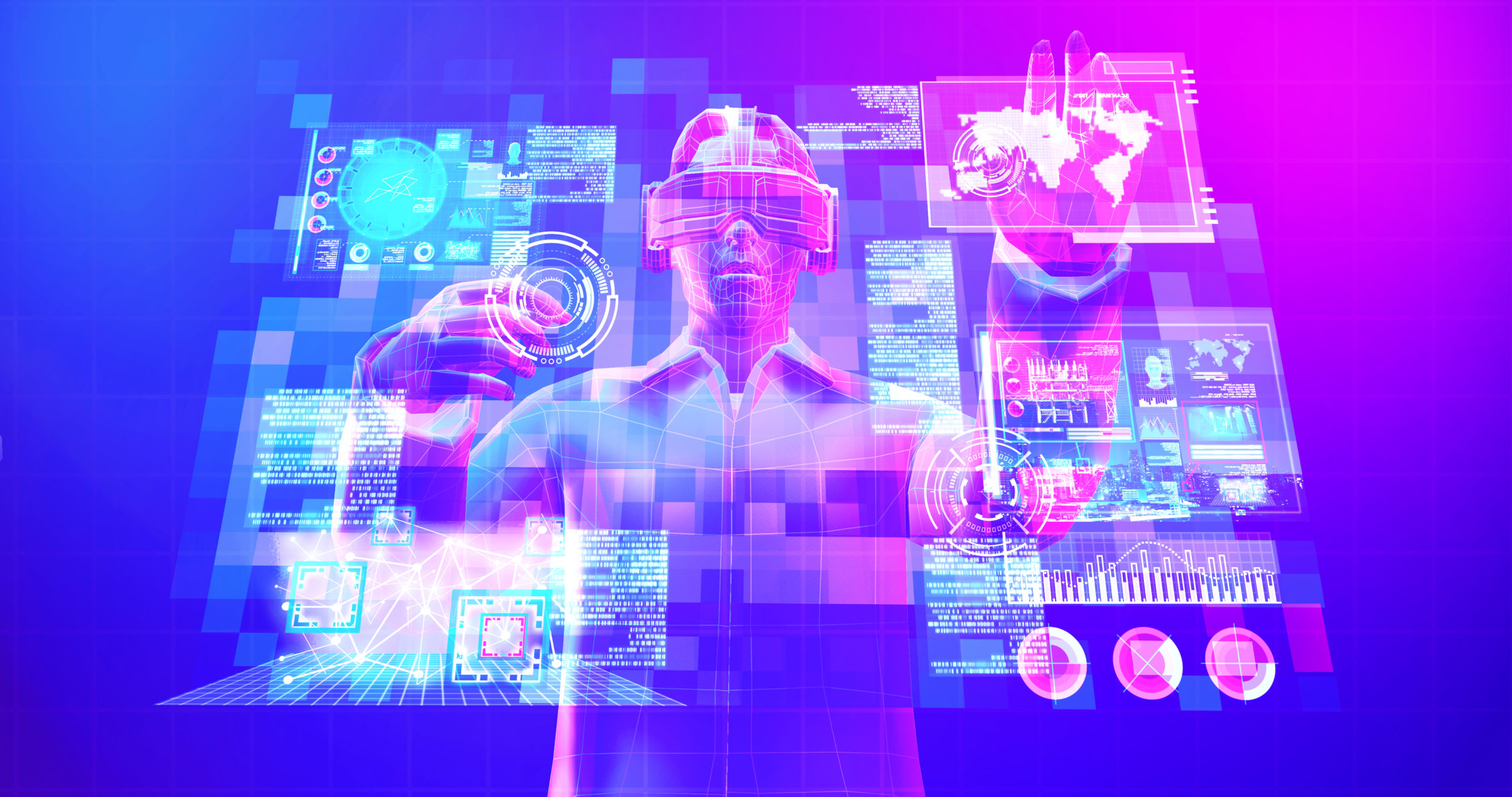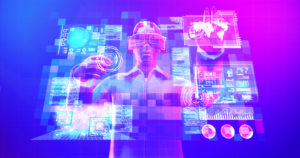
What does the metaverse mean for the future workplace?
November 15, 2021
Artificial Intelligence, Article, Trends
The metaverse promises to create an immersive, interactive and shared digital world that brings together mixed reality – augmented reality (AR) and virtual reality (VR) – along with 3D holographic avatars, IoT and digital twins. It is seen as the next great leap in the evolution of the internet with tech titans such as Meta, Microsoft and NVIDIA announcing their vision of this alternate universe. So, beyond the hype what does it mean for the future workplace?
The pandemic has changed traditional office working in favour of a hybrid mix of remote and virtual collaboration. Now, we see a future where a ‘metaverse’ promises to create immersive virtual experiences that could break down the divides between office and remote working.
From science fiction to reality?
Author Neal Stephenson coined the term ‘metaverse’ in his 1992 science fiction novel Snowcrash. In the book, the Metaverse is a collective shared virtual space that combines virtually enhanced physical space with physically visible virtual worlds. It included the sum of all virtual worlds, augmented reality, and the internet. However, the concept could be dated further back to William Gibson’s Neuromancer from 1984 where the metaverse was depicted under a different term: “cyberspace”. Today, online role-playing games like World of Warcraft, Minecraft and Roblox already embrace elements of the metaverse.
While thoughts of a metaverse may create feelings of apprehension and fear, the merging of our physical and digital lives is already underway – we are already reliant on screens and pixels, with many of us living and working behind screens. Like it or not, the tech giants are working on the technology, platforms and infrastructure to make this a reality – even if it is 5 to 10 years away.
Meta, formerly Facebook, Inc., the umbrella company covering Facebook, Instagram, Messenger, WhatsApp and other technologies, has made significant investments in AR and VR – including its acquisition of Oculus in 2014. Its Oculus Quest VR headset product line will be known as Meta Quest from 2022. Meta’s metaverse is known as Horizon and Horizon Workrooms and is now in open beta. This is Meta’s flagship collaboration experience that enables people to work in the same virtual room, regardless of physical distance. VR headsets allow teams to interact using digital avatars in a shared online office. This is not simply video calls with a headset – team members interact with avatars, share digital whiteboards and experience directional audio.
Microsoft is also gearing up its own metaverse vision, building on HoloLens mixed reality headset technology and its acquisition of AltspaceVR in 2017. Shortly after Facebook rebranded to Meta, Microsoft announced it is bringing the mixed reality capabilities of Mesh, its collaborative platform for virtual experiences, to Microsoft Teams in 2022. This will allow the use of 3D animated avatars and will work with or without a VR headset. Businesses will be able to build their own metaverses or virtual spaces inside of Teams. Microsoft’s metaverse technology stack includes Microsoft Mesh, Azure IoT, Azure Digital Twins and analytics.
Most recently, Microsoft and Meta announced Teams Integration with Workplace, enabling employees to access content from Workplace within Teams. This partnership brings together two major rivals, and although Teams boasts a much larger paid user base (200 million as of July 2021) than Workplace from Meta (7 million users as of May 2021), it is one step in accelerating the journey to an enterprise metaverse. However, whether people want to mix their personal social media with their business lives, and issues around trust and privacy, will be of concern.
Meanwhile semiconductor NVIDIA recently announced plans for its Omniverse platform, an open-source tool that allows users to build virtual worlds. NVIDIA describes the Omniverse as a simulation and collaboration platform that “serves as a connective tissue for physically accurate virtual 3D worlds”. For instance, Omniverse is used to build digital twins (digital 3D replicas of physical assets) by Ericsson, as the company creates virtual versions of cities to determine how to deploy its 5G networks.
Printing in the enterprise metaverse
To realise the enterprise metaverse, there will be a requirement for digital twin technology, IoT sensors and mixed reality. This will bring opportunities to create workspaces that allow for both physical and digital interactions. Companies can already unlock some of the potential of the metaverse through the analysis of data from connected environments, using this to evaluate outcomes, while harnessing AI to improve and automate tasks.
The true potential of AR is already being realised in areas such as predictive maintenance. Here it can leverage ML to track data from past device and predict the future can lead to the replacement of items before failure, or to the extended use of items as failure is less likely to happen. Companies can use the metaverse to identify when a component is likely to fail – and can also optimise energy use and reduce downtime while doing this.
When it comes to the print industry, AR is starting to be applied, but so far mainly on the service side. On 9th November HP announced HP xRServices, powered by Microsoft Hololens 2 targeted at its industrial printers. HP xRServices creates a virtual/real world combination in which customers can connect with HP engineers in a split second through mixed reality, advising them on any issue, at any point of their print production.
Meanwhile Xerox CareAR enables service teams anywhere to instantly provide remote visual AR support for their customers, employees and field workers.
However, the use of mixed reality for virtual collaboration poses a threat to print in an already declining market. For instance, Horizon Workrooms includes a virtual whiteboard where you can use your controller like a pen, either on the physical desk or standing with others at the whiteboard. Also, in a virtual world, ‘print’ may be an electronic process where ‘paper’ is a projection of data into a VR environment. Print manufacturers will need to consider such digital print technologies to participate in the metaverse.
The immersive workplace
Although time will tell how the metaverse will redefine work, we are already seeing a blurring of physical and digital worlds. Suppliers must be able to deliver the technological agility and flexibility that the workforce demands. It’s only a matter of time before such changes in technology use cause major changes in how organisations interact with their suppliers.
VR and AR is certainly moving beyond the realms of online gaming and as businesses look to develop virtual office environments, the metaverse may provide the answer to the challenges of replicating physical in-person interactions. Some businesses are already looking to create low-touch office spaces based on digital tools covering areas such as occupancy monitoring, hot desk booking, smart heating, etc.
Creating an immersive experience for remote and office-based workers could improve the employee experience and level the playing field across those physically working in the office and those working from home. Undoubtedly, concerns about data and privacy will be an issue, but it may be one way to foster effective collaboration as employees make a return to working via a hybrid office/home environment.
VR may not be ready today – wearing a headset for more than an hour is cumbersome and until lightweight effective AR glasses become available at the right price, it is likely that AR will remain an environment for the tech enthusiasts and those with highly specialised needs, such as surgeons. Do we really want to interact with poorly managed avatars or holograms where facial mannerisms are not particularly well presented or the person we are interacting with appears cartoonish? Does it mean that once we assume a digital identity in this way all our interactions will be tracked and monitored?
Whether the metaverse signals a dystopian future or not, it is still at the early stages. As with many technologies, it is likely that it will mature rapidly and that users will tease out what makes sense for them, leaving behind many areas that technologists thought would be of great interest. However, the opportunities are vast and we can expect more tech giants, along with a large ecosystem of smaller point players, to invest in metaverse ambitions.
You have Successfully Subscribed!
Stay ahead with industry insights
Receive Quocirca’s latest articles and research updates




